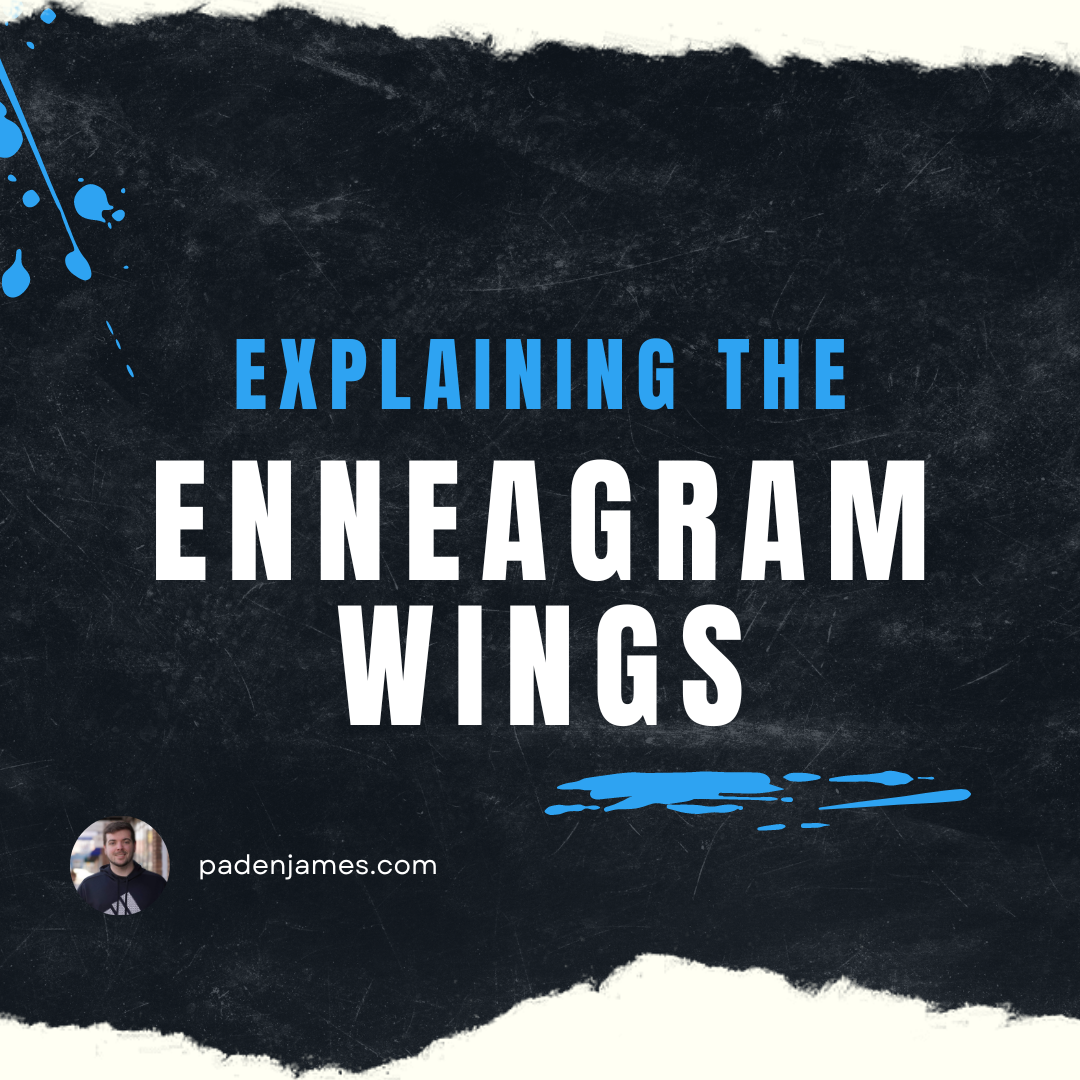Have you been on social media or talking to someone about the Enneagram, and they say something like “I’m a 2 wing 1,” or “I am a 7 with a 6 wing”, or, incorrectly (and we’ll get to why in just a bit), something along the lines of “I’m a 4 with a 9 wing”?
It could be a bit confusing, especially when you’ve taken the time to get clarity on your Enneagram type. What are these people talking about? What are the Enneagram wings? There’s more to the Enneagram than the 9 types? I’ll answer all your burning questions about Enneagram wings in this post.
What are the wings in the Enneagram system?
If you haven’t nailed down your core type, I highly advise that you read more about the Enneagram system, how it works, and get an understanding of the 9 core types within the system. Though understanding your wings is important, it doesn’t do much good if you aren’t clear on your core type. So, find your main type first.
It’s also important to look at the Enneagram itself. The shape of the Enneagram matters – there are reasons why the numbers are positioned where they are, as well as all of the lines “connecting the dots”, so to speak. We’ll get into those later. For now, look at your main type on the Enneagram. The wings for any type are the two neighboring, adjacent numbers next to that number.
Let’s say you’re a Type 9, for example. The enneagram wings for the Type 9 would be the 1 and the 8. Your wings can only be those neighboring types. And that’s why I think it’s funny when people say they’re a 9 with a 4 wing, or something like that – because that is not a possible combination in the enneagram.
Now, that being said, there are reasons why someone might resonate with both of those types, even if they’re not types that are connected in the Enneagram system. And that gets into things like subtypes, levels of health, and even tritypes. But that’s a bit advanced for the topic at hand, so let’s get back to discussing wings.
Different Enneagram experts and enthusiasts have nuances in how they teach or describe how your wings work. I’ve always viewed each type as being able to access and utilize both numbers that are their wings, though one is typically more fitting, natural, and dominant in your personality than the other might be.
The more dominant wing influences your personality. It doesn’t negate the core motivations of your main, core type, but the wings will blend in some characteristics and influences of the neighboring types. Therefore, though I think you can (and should) lean into both wings, especially when it comes to being a balanced person.
People tend to unconsciously have their core type and a dominant wing show up in their life and their personality, and stretching into the wisdom of the neighboring types can contribute to more balance, growth, and well-being.
Let’s stick with the Type 9 example. The Enneagram Type 9 is typically called The Peacemaker, focused on having harmony in their internal and external world, wanting to keep the peace, go with the flow, and typically not being assertive, dominant, or demanding.
They tend to be able to see, empathize, and resonate with a multitude of perspectives without bias; therefore, they are naturally great at mediating conflict.
However, they may struggle to assert or speak up about their own needs and desires, or suppress what they want in order to keep peace, comfort, and harmony a priority.
The two wings for the Type 9s can cause them to show up a bit differently than the 9 might naturally react or be motivated by. The Type 1’s, the Reformers or Perfectionists, influence as a wing will not negate the core motivations of the Type 9, but will influence it by bringing out more idealism, ethics, a strong sense of duty, doing the right things, doing things in the right way, and doing things well – going above and beyond reproach.
Their sense of value comes from being good, ethical, and morally upstanding. This could ‘flavor’ the 9’s personality, especially if the 1 wing is quite strong/dominant in their life.
The core weakness of sloth and being prone to procrastination, being doing-repressed and low-energy people, or being unaware and unaffected by resentment or criticism may come out a bit differently in a 9w1. They will take on some of those Type 1 characteristics, blended with the core motivations of the Type 9.
On the other side, a Type 8 may be more assertive, action-oriented, outspoken, aggressive, and externalize more of their internal anger, passion, or lust – and more forcefully push back against being controlled, manipulated, told what to do, etc. These are things that the Type 9 would typically repress or even not be aware of or in tune with.
I’ve heard people describe the wings as being ‘salt and pepper’ added to the main type. Though that’s a good analogy, I like to think of it more as different shades of colors.
If each of the 9 types represented a color, then the strength of your wings (combined with your type’s main color) would bring out a different shade.
Though your type’s color may still be blue, for example, it could be a different shade of blue. While we may see a color as blue, the various shades can bring about a different appearance, feeling, experience, etc.
Why are the wings important?
Well, the first reason I’d say that wings are important is on the topic of self-awareness. Beyond just being aware of how your wing influences your personality type, it also can help you understand why you may show up in the world in different ways through your actions, passions, strengths, reactions, pet peeves, core values, etc.
The influence of the wings of your type sheds light on why you may not always look like your main type. This is especially helpful for a couple of reasons: one, it can help you get clarity on your main type if you’re stuck between two neighboring types – the core driving motivations go first, but the wings can influence those motivations with the wing’s unique spin. The second is that, especially if you notice that a wing is more dominant or present in your personality, you can utilize the wisdom and growth attributed to it and integrate it into your personality.
Another note is that if you tend to lean more into one wing than another, you are likely either neglecting, avoiding, or repressing the strengths and wisdom that come from the non-dominant wing. Being able to stretch into the non-dominant wing, though this can be quite challenging and unintuitive, will bring forth more growth, balance, and well-roundedness to your personality.
For example, if you are a type 5 with a dominant 4 wing, you are likely a very withdrawn, introspective, and guarded person who likely avoids the community-oriented, loyal, compliant, and security-driven connectedness that the type 6 primarily focuses on. And these are likely areas in which you tend to struggle and feel an imbalance in your life.
If you were to lean into the traits, wisdom, and motivations of the 6 wing more, you’d find more balance and wholeness in your life as opposed to neglecting it, which might naturally be the easier thing to do. So, by being aware of your wings and your imbalances, you can find ways to be more balanced, present, and grow in these life areas.
Can your wings change?
This is a question that I’ve wondered for quite some time. The short answer is, no, your wings are your wings. As I mentioned before, you have two wings, the types that are adjacent to your main type (for example, type 9s have 1 and 8 as their wings).
But this question is more likely referring to the dominant wing. Yes, I think that the wing you associate with more can change, thus a reason why the Enneagram is so interesting. The Enneagram takes into account the fluidity of life, how we can gravitate to our wings (and other things like arrows, subtypes, etc., which we will cover in another post), and how that shifts depending on many different life factors.
Whether it’s through intentional growth and development, life experiences, or changes in priorities as we go through our lives, our focus and the strengths (and weaknesses) we gravitate toward in our main type and our wings can change. The main type’s priorities are still there, and the wings are still the same, but I believe the wings we stretch into (and when and why) can change over time.
What’s the difference between your main Enneagram type and your Enneagram wings?
Humans are complex, multifaceted, layered, intricate, and unique beings. It’s impossible to define the entirety of the human race by just 9 types. The Enneagram doesn’t claim to do that, which I believe is a big misunderstanding that many people have.
The Enneagram helps shed light on a system in which we can see how we cope, react, defend ourselves, act under stress, act in growth, and blend with other types as an interconnected system. It helps us to better understand ourselves and relate to each other.
The wings are an important part of that intricate layering, which is why two people may be the same Enneagram type but show up in the world looking completely different from each other.
As I mentioned earlier, your wings add to the various shades of colors of your personality. They don’t overtake your personality, nor do they negate your core motivations. Your main type is your main type because of your core motivations. What drives you? Why do you do what you do?
Though stereotypes and common patterns arise from people of the same type, your Enneagram type is not determined by behaviors. Your main type is determined by your core motivation and focus in the world.
The presence of your wings influences how you focus on your type’s core motivation or how it ‘flavors’ your personality by adding nuance to your main type.
Additionally, your type’s wings can help you see how you’re heavily imbalanced with certain areas of focus and where you could intentionally work to be more balanced in life by stretching into the non-dominant wing.
Next Steps
Start by getting clear on your main type, and then learn about the two adjacent types (your wings). See how your wings influence how you show up in the world and how you can utilize them for self-awareness, growth, and balance in your life.



